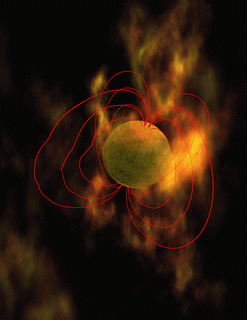Magnetic mystery solved

Magnetars - stars with magnetic fields a thousand million million times stronger than Earth's - are formed when some of the biggest stars in the cosmos explode, says a team led by Australian ex-pat Bryan Gaensler of the Harvard-Smithsonian Center for Astrophysics.
The astronomers base their conclusions on a study made with CSIRO's Australia Telescope Compact Array and Parkes radio telescope in eastern Australia.
"The source of these very powerful magnetic objects has been a mystery since the first one was discovered in 1998, says Gaensler. "Now we think we've nailed it."
Image: Artist's conceptions of a magnetar - a neutron star with a super-strong magnetic field, represented by the lines in these illustrations.
Magnetars have magnetic fields so strong that, if one were located halfway to the Moon, it could wipe the data from every credit card on Earth. Astronomers think magnetars are a kind of neutron star - a city-sized ball of neutrons created from a star's core when then the star explodes as a supernova at the end of its life.
Only about 10 magnetars are known. But while magnetars are very rare, another form of neutron star, called a pulsar, is much more common. Astronomers have found more than 1500 of them. Magnetars spit out bursts of high-energy X-rays or gamma rays. Normal pulsars emit beams of low-energy radio waves.
"Both radio pulsars and magnetars tend to be found in the same regions of the Milky Way, in areas where stars have recently exploded as supernovae," explains Gaensler.
"The question has been: if they are located in similar places and are born in similar ways, then why are they so different?"
Previous research has hinted that the mass of the original, progenitor star might be the key. Recent papers by Eikenberry et al (2004) and Figer et al (2005) have suggested this connection, based on finding magnetars in clusters of massive stars.
"Astronomers used to think that really massive stars formed black holes when they died," says Dr Simon Johnston of CSIRO's Australia Telescope National Facility.
"But in the past few years we've realised that some of these stars could form pulsars, because they go on a rapid weight-loss program before they explode as supernovae."
These stars lose a lot of mass by blowing it off in winds that are like the Sun's solar wind, but much stronger. This loss would allow a very massive star to form a pulsar when it died.
To test this idea, Gaensler and his team investigated a magnetar called 1E 1048.1-5937, located approximately 9,000 light-years away in the constellation Carina. For clues about the original star, they studied the hydrogen gas lying around the magnetar, using data gathered by CSIRO's Australia Telescope Compact Array radio telescope and its 64-m Parkes radio telescope. A map of the hydrogen gas shows a striking hole in the gas around the magnetar.
"The evidence points to this hole being a bubble carved out by the wind that flowed from the original star," says Naomi McClure-Griffiths of CSIRO's Australia Telescope National Facility, one of the researchers who made the map.
The characteristics of the hole indicate that the progenitor star must have been about 30 to 40 times the mass of the Sun. Another clue to the difference between magnetars and pulsars may lie in how fast neutron stars are spinning when they form.
Gaensler and his team suggest that heavy stars will form neutron stars spinning at up to 500-1000 times per second. Such rapid rotation should power a dynamo and generate super-strong magnetic fields. 'Normal' neutron stars are born spinning at only 50-100 times per second, preventing the dynamo from working and leaving them with a magnetic field 1000 times weaker, says Gaensler.
"A magnetar goes through a cosmic extreme makeover and ends up very different from its less exotic radio pulsar cousins," he says.
If magnetars are indeed born from massive stars, then one can predict what their birth rate should be, compared to that of radio pulsars.
"We estimate that the magnetar birth rate will be only about a tenth of that of normal pulsars," says Gaensler. "With the ten or so such sources we now know of, we may have already discovered almost all the magnetars that are out there to be found."
PUBLICATION
B. M. Gaensler, N. M. McClure-Griffiths, M. S. Oey, M. Haverkorn, J. M. Dickey & A. J. Green, "A Stellar Wind Bubble Coincident with the Anomalous X-ray Pulsar 1E 1048.1-5937: Are Magnetars Formed From Massive Progenitors?" This paper has been accepted for publication in The Astrophysical Journal Letters.
Source: CSIRO


















